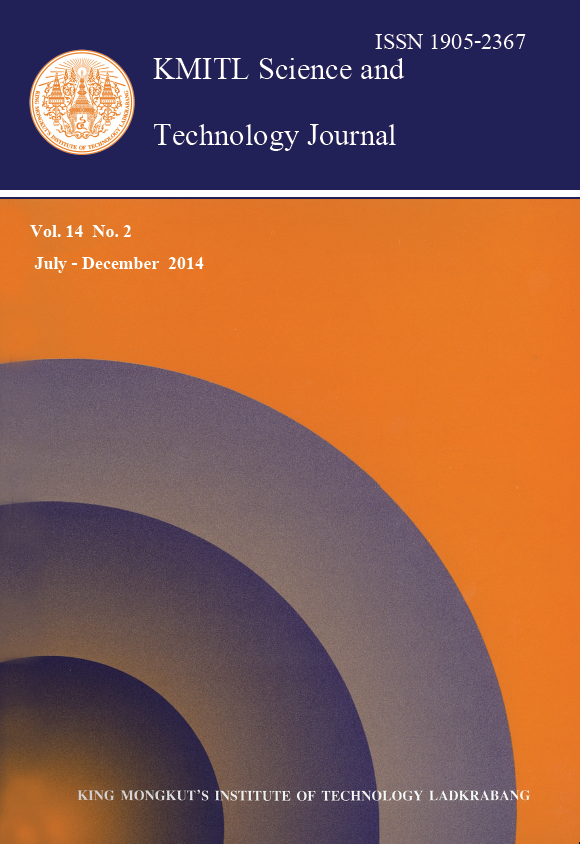Dynamics of Host-Parasitoid Populations and Biological Control
Main Article Content
Abstract
In this article, we propose the host-parasitoid model that takes into account the duration of developing to be the mature parasitoid after the eggs were laid in host and the effect of refuge in host population for hiding from predation. The existence of critical time delay for unstable coexist equilibrium is examined. The successful biological control to suppress the abundance of an insect pest causing damage to crops is also discussed.
Keywords: Host, Parasitoid, Insects, Refuge, Time Delay, Biological Control
*Corresponding author: E-mail: nichaphatb@kmutnb.ac.th
Article Details
Copyright Transfer Statement
The copyright of this article is transferred to Current Applied Science and Technology journal with effect if and when the article is accepted for publication. The copyright transfer covers the exclusive right to reproduce and distribute the article, including reprints, translations, photographic reproductions, electronic form (offline, online) or any other reproductions of similar nature.
The author warrants that this contribution is original and that he/she has full power to make this grant. The author signs for and accepts responsibility for releasing this material on behalf of any and all co-authors.
Here is the link for download: Copyright transfer form.pdf
References
[2] Mahr, D.L., Whitaker, P. and Ridgway, N. 2008. Biological Control of Insects and Mites: An Introduction to Beneficial Natural Enemies and Their Use in Pest Managemment. Madison, University of Wisconsin Cooperative Extension.
[3] Mills, N.J. and Getz, W.M. 1996. Modelling the Biological Control of Insects Pests: A Review of Host-Parasitoid Model, Ecological Modelling, 92, 121-143.
[4] Mills, N.J. 2000. Biological control: the need for realistic models and experimental approaches to parasitoid introductions. Princeton NJ, Princeton University Press.
[5] Vinson, S.B. 1976. Host Selection by Insect Parasitoid, Annual Review of Entomology, 21, 109-133.
[6] Anderson R.M. and May, R.M. 1978. Regulation and Stability of Host-Parasite Population Interactions, Journal of Animal Ecology, 47, 219-247.
[7] Hassell, M.P. 1978. The Dynamics of Arthropod Predator-Prey Systems. Princeton NJ, Princeton University Press.
[8] Godfray, H.C.J., Hassell, M.P. and Holt, R.D. 1994. The Population Dynamic Consequences of Phenological Asynchrony between Parasitoids and their Hosts, Journal of Animal Ecology, 63, 1-10.
[9] Mills, N.J. 2001. Factors Infulencing Top-Down Control of Insect Pest Populations in Biological Control Systems, Basic and Applied Ecology, 2, 323-332.
[10] Schley, D. and Bees, M.A. 2006. The Role of Time Delays in a Non-Autonomous Host-Parasitoid Model of Slug Biocontrol with Nematodes, Ecological Modelling, 193, 543-559.
[11] Hastings, A. 1984. Delays in Recruitment at Differenct trophic Levels: Effects on Stabiltiy, Journal of Mathematical Biology, 21, 35-44.
[12] Holt, R.D. and Polis, G.A. 1997. ATheoretical Framework for Intraguild Predation, The American Naturalist, 149, 755-764.
[13] Nakazawa, T. and Yamamura, N. 2006. Community Structure and Stability Analysis for Intraguild Interactions Among Host, Parasitoid, and Predator, Population Ecology, 48, 139-149.
[14] Beddington, J.R., Free, C.A. and Lawton, J.H. 1978. Characteristics of Successful Natural Enemies in Model of Biological Control of Insect Pests, Nature, 273, 513-519.
[15] Murdoch, W.W. 1990. Ecological Basis for Biological Control. Andover, Intercept.
[16] Hochberg, M.E. and Holt, R.D. 1999. The Uniformity and Density of Pest Exploitation as Guieds to Success in Biological Control. Cambridge, Cambridge University Press.
[17] Puangsun, S. and Patanarapeelert, K. 2012. An SIR Epidemic Model with Gravity in Patchy Environment: Analyses for Two Patches System, KMITL Science and Technology Journal, 12(2), 127-133.
[18] Sangsawang, S., Tanutpanit, T., Mumtong, W., and Pongsumpun, P. 2012. Local Stability Analysis of Mathematical Model for Hemorrhagic Conjunctivitis Disease, KMITL Science and Technology Journal, 12(2), 189-197.


